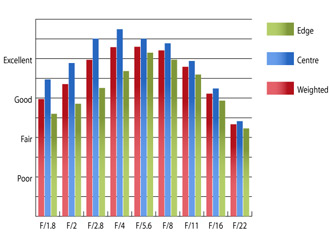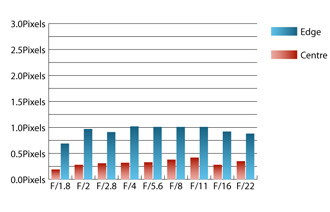Nikon AF-S Nikkor 35mm f/1.8G DX
Nikon AF-S 35mm f/1.8G DX Performance
This lens puts in an excellent optical performance at every aperture. Sharpness is already very good in the centre at maximum aperture and the quality towards the edges is fairly good.
Stopping the lens down improves sharpness across the frame, with peak quality being achieved between f/4 and f/5.6. Here the sharpness in the centre is outstanding and the quality towards the edges is excellent.
Resolution at 35mm | How to read our graphs |
 | The blue column represents readings from the centre of the picture frame at the various apertures and the green is from the edges. Averaging them out gives the red weighted column. The scale on the left side is an indication of actual image resolution. The taller the column, the better the lens performance. Simple. For this review, the lens was tested on an Nikon D300 using Imatest. |
Chromatic aberrations are also well controlled, hovering just under one pixel in width towards the edges at most apertures. This level of fringing should pose few issues, even in large print sizes or harsh crops from the edges of the frame.
Chromatic Aberrations at 35mm | How to read our charts |
 | Chromatic aberration is the lens' inability to focus on the sensor or film all colours of visible light at the same point. Severe chromatic aberration gives a noticeable fringing or a halo effect around sharp edges within the picture. It can be cured in software. Apochromatic lenses have special lens elements (aspheric, extra-low dispersion etc) to minimize the problem, hence they usually cost more. For this review, the lens was tested on an Nikon D300 using Imatest. |
Falloff of illumination towards the corners is very well controlled, especially for a wide aperture lens. At f/1.8 the corners are only 0.41 stops darker than the image centre and illumination is visually uniform at f/2.8.
Distortion is stronger than I would expect from a fixed focal length lens. Imatest detected 2.4% barrel distortion, which will become apparent in images with straight lines towards the edges of the frame. Luckily the distortion pattern is uniform, so this should be easy enough to correct in image editing software afterwards.
Flare is kept well under control, even when shooting into strong light sources like the sun. Contrast holds up well under these conditions too. A circular lens hood is supplied with the lens which does an excellent job of protecting the lens from extraneous light that may cause flare.
Add your message
Login required
Please login here or if you've not registered, you can register here. Registering is safe, quick and free.
Please login here or if you've not registered, you can register here. Registering is safe, quick and free.
photodo Stats
1102 lenses
428 MTF tests
74 in-depth photodo reviews
100+ users join each day
Help the lens community by reviewing or rating a lens today via our lens search
428 MTF tests
74 in-depth photodo reviews
100+ users join each day
Help the lens community by reviewing or rating a lens today via our lens search
Latest Lens Reviews
- Chinon 28mm f/2.8 Vintage Lens Review
- Canon EF 70-200mm f/4L IS II USM Lens Review
- Samyang AF 85mm f/1.4 EF Review
- Sigma 70mm f/2.8 DG Macro Art Review
- Samyang AF 24mm f/2.8 FE Review
- Meike 50mm f/1.7 Review
- Tamron 70-210mm f/4 Di VC USD Review
- Lensbaby Burnside 35mm f/2.8 Review
- Asahi Super Takumar 50mm f/1.4 Review
- Asahi Super-Multi-Coated Takumar 135mm f/3.5 Review








